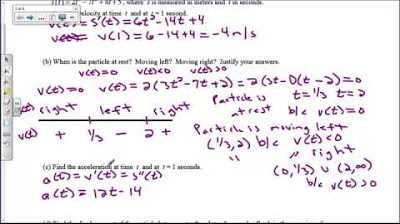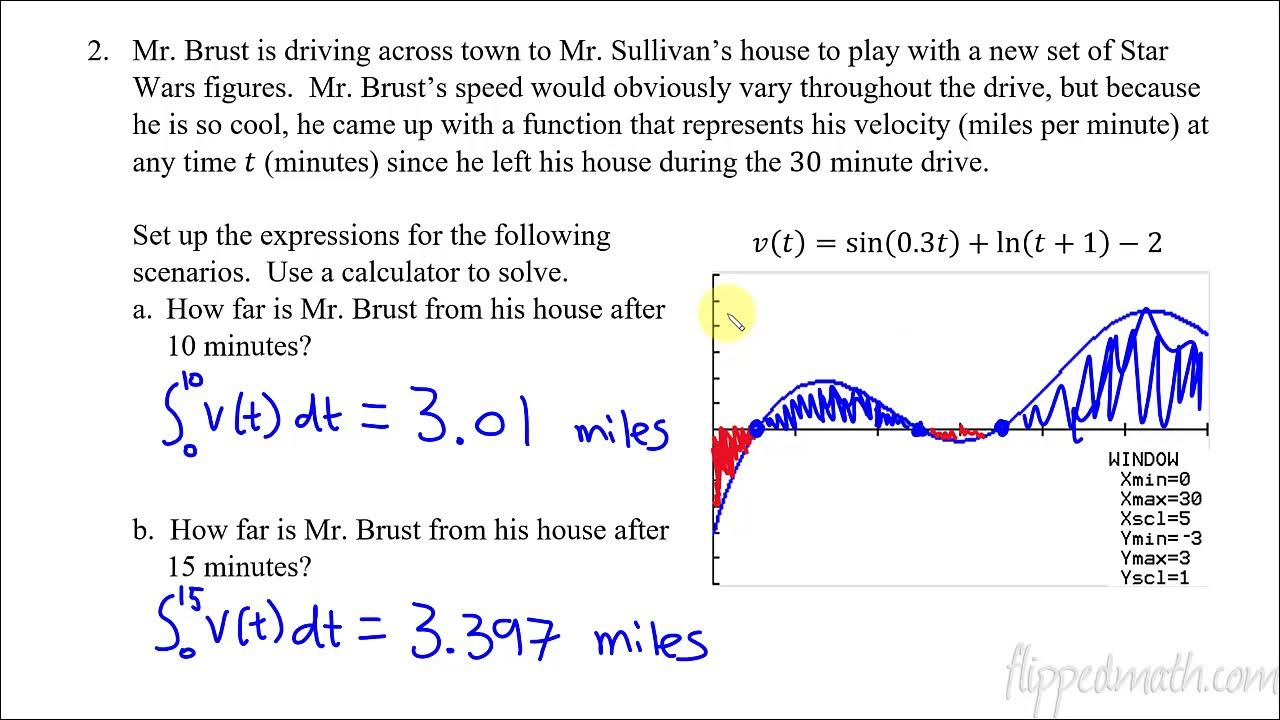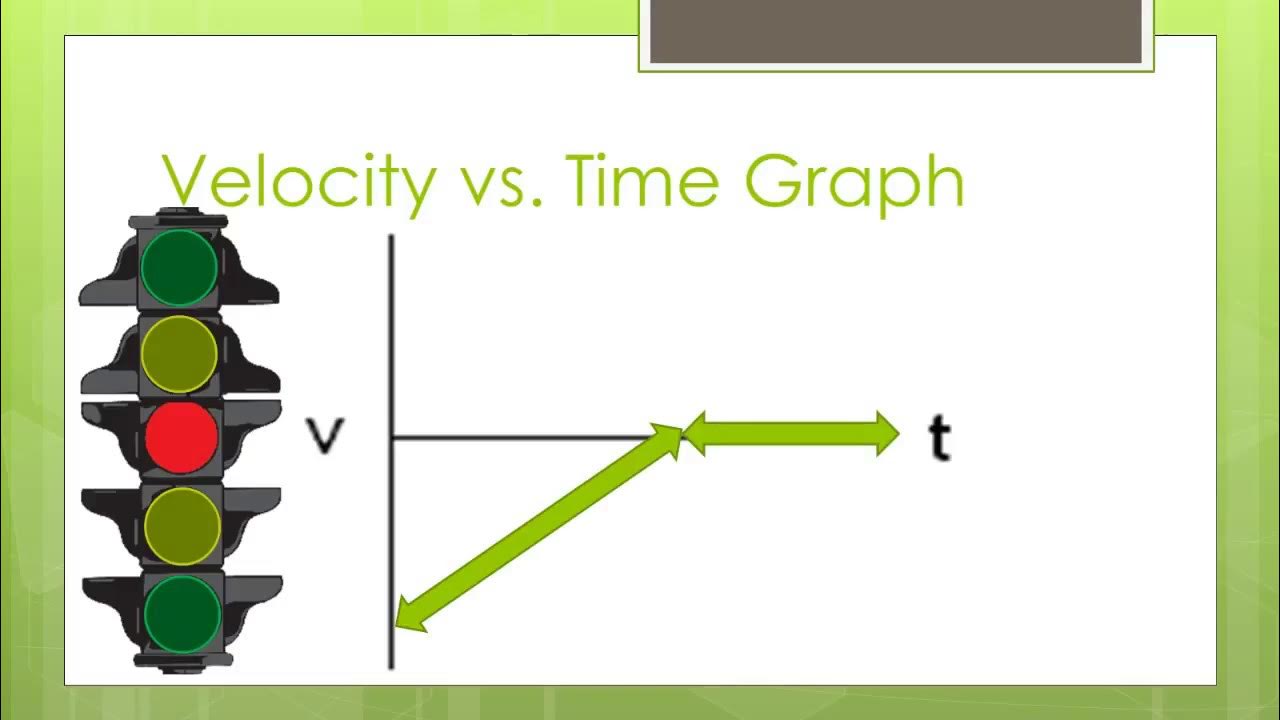when does a particle speed up or slow down?
TLDRThis educational video script explores the concept of a particle's acceleration by examining its position, velocity, and acceleration functions. It explains that an object speeds up when the signs of its velocity and acceleration agree. The script guides through deriving the velocity and acceleration functions, finding critical points, and creating a sign chart to determine when the particle speeds up. The analysis concludes that the object accelerates on the interval from 3 to 4 and from 5 to infinity, providing a clear understanding of the conditions for acceleration.
Takeaways
- 📚 The problem is about determining when a particle speeds up based on its position function.
- 🔍 An object speeds up when its velocity and acceleration have the same sign, indicating they agree in direction.
- 📈 The velocity function is the first derivative of the position function, and the acceleration function is the second derivative.
- 🌱 The velocity function given is \(3t^2 - 24t + 45\), and the acceleration function is the derivative of velocity, which simplifies to \(60 - 24 = 36\).
- 🔍 To analyze the signs of velocity and acceleration, critical numbers are found by setting the velocity function equal to zero, resulting in \(t = 3\) and \(t = 5\).
- 📊 A sign chart is used to determine the intervals where the velocity and acceleration have the same sign, indicating when the particle speeds up.
- 📍 The critical numbers divide the number line into intervals: \(0\) to \(3\), \(3\) to \(5\), and beyond \(5\).
- 🚀 Test values are chosen within each interval to determine the sign of the velocity and acceleration functions.
- 🔄 The velocity function changes sign at \(t = 3\) and \(t = 5\), indicating the object's direction changes from right to left and vice versa.
- 🔄 The acceleration function is constant and positive, except at \(t = 4\) where it is zero, indicating the object's rate of speed change.
- 🏁 The particle speeds up during the intervals \(3 < t < 4\) and \(t > 5\), where the velocity and acceleration have the same sign.
Q & A
What is the main problem addressed in the script?
-The main problem addressed is determining when a particle speeds up, based on its position function, velocity, and acceleration.
When does an object speed up according to the script?
-An object speeds up when its velocity and acceleration have the same sign.
What functions are needed to analyze the particle's motion?
-The velocity function and the acceleration function are needed to analyze the particle's motion.
How is the velocity function derived from the position function?
-The velocity function is derived as the first derivative of the position function.
What are critical numbers in the context of the velocity function?
-Critical numbers are the values of time when the velocity function is zero, indicating the particle is at rest.
How is the acceleration function derived?
-The acceleration function is derived as the derivative of the velocity function, which is also the second derivative of the position function.
What does the script use to determine the signs of the velocity and acceleration functions?
-The script uses a sign chart to determine the signs of the velocity and acceleration functions.
How are test values used in the sign chart?
-Test values are picked within each interval on the number line to determine the sign of the velocity and acceleration functions within those intervals.
What intervals are found for the velocity function in the script?
-The intervals found are between 0 and 3, 3 and 5, and beyond 5.
During which intervals does the particle speed up according to the script?
-The particle speeds up in the intervals from 3 to 4 and from 5 to infinity, where the signs of velocity and acceleration agree.
Outlines
📈 Determining When a Particle Speeds Up
This paragraph explains that to determine when a particle speeds up, we need to analyze when its velocity and acceleration have the same sign. It introduces the position function and derives the velocity function using differentiation. The velocity function is then factored to find critical points where the object is at rest, which are used to create a sign chart for further analysis.
🔄 Analysis of Velocity and Acceleration Signs
This paragraph continues by analyzing the signs of the velocity function across different intervals using a sign chart. It also derives the acceleration function and uses test values to determine its sign across intervals. The paragraph concludes by combining the velocity and acceleration sign charts to identify the intervals where both have the same sign, indicating when the particle speeds up.
Mindmap
Keywords
💡Particle
💡Position Function
💡Velocity
💡Acceleration
💡Sign Chart
💡Critical Numbers
💡Derivative
💡Factoring
💡Interval
💡Test Values
💡Speeding Up
Highlights
The problem focuses on determining when a particle speeds up based on its position function.
An object speeds up when its velocity and acceleration have the same sign.
The velocity function is the derivative of the position function.
The acceleration function is the second derivative of the position function.
Critical numbers are found by setting the velocity function equal to zero.
The object is at rest at times t=3 and t=5.
A sign chart is used to analyze the signs of velocity and acceleration.
The velocity function is tested for intervals between 0 and 3, 3 and 5, and beyond 5.
The acceleration function is tested for intervals between 0 and 4, and beyond 4.
The object speeds up when both velocity and acceleration are positive or both are negative.
The object is speeding up on the interval from 3 to 4 and from 5 to infinity.
The sign chart shows the intervals where the object's velocity and acceleration agree.
The object's velocity and acceleration do not agree between t=4 and t=5.
The method involves finding the roots of the velocity function and analyzing its sign intervals.
The acceleration function is simplified to 60 - 24t to find when it equals zero.
The object's speed is analyzed by considering both its direction and magnitude of velocity and acceleration.
The solution process involves a detailed examination of the particle's motion over time.
Transcripts
Browse More Related Video

Slowing Down Speeding Up Derivatives Application Calculus MCV4U

Use Position Function to Determine the Vel and Acc Funct and When Object is Speeding Up or Slowing

Particle Motion - Speeding Up and Slowing Down (Example, AP Calculus)

Particle MotionDay1

Calculus AB/BC – 8.2 Connecting Position, Velocity, and Acceleration of Functions Using Integrals

Position, Velocity, and Acceleration vs. Time Graphs
5.0 / 5 (0 votes)
Thanks for rating: